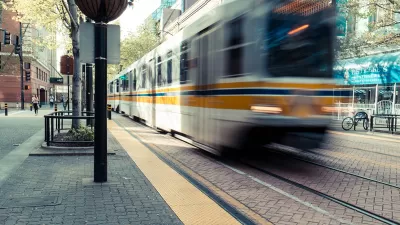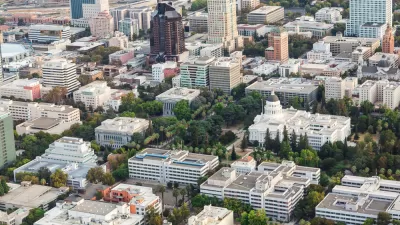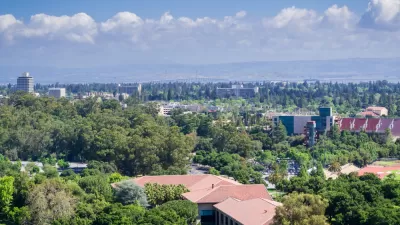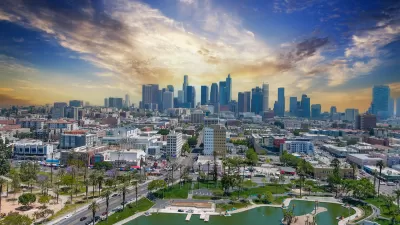Opponents of bills to promote transit oriented housing development throughout California need to do the math and develop some state pride.

Last year, Californians engaged in one of the liveliest debates over planning in recent memory with the introduction of Senate Bill 827, which was designed to promote development of housing around "high-quality public transportation" or "within a job rich, high-opportunity neighborhood" statewide. As nice as this goal may sound to progressive planers, the debate featured hyperbolic, factually dubious, and sometimes mean-spirited arguments that eventually killed the bill. I expect the same for SB 827’s successor, Senate Bill 50, which was introduced a few weeks ago.
This debate revealed an unfortunate truth about California, and about jurisdictions generally that are larger than a single-family lot: it’s difficult to see ourselves as a single, interrelated polity, and it’s even harder to reap the benefits of being a single, interrelated polity. Policymaking promotes these views. The fundamental tension in California planning surrounds the fact that everything to do with demographics is administered at the state level, while housing is administered at the local level.
Many opponents of SB 827 seized on rumors and memes about an invasion of high-rises, as if all of the housing was going to descend upon a single transit node. In reality, SB 827 and SB 50, both authored by State Sen. Scott Weiner, try to promote the opposite. Whichever version of the bill passes – or whichever version of the bill gets shot down – the solution to California’s housing crises (and similar crises in other high-priced regions of the country) depends more on values than on any specific piece of legislation. To embrace greater density, California first must embrace a common destiny.
But first, some math.
California needs an estimated 3.4 million more units than it currently has. If we overestimate wildly and assume that half of those units might be built in SB 50-compliant zones—with the rest mushrooming in the hinterlands like usual—we need to do the math to figure out whether suburbs like Pleasanton or Sierra Madre will turn into seething megacities.
How many "high quality" transit stops does California have? I don't have an authoritative figure for that, but here are some neat visualizations of what SB 827 could have done around a single transit stop and around all of the state's SB 827-qualifying transit stops. Neither site totals up the number. But let's look just at rail stops: between Los Angeles (93), the Bay Area (45), San Diego (53), and Sacramento (52), there are 243 heavy and light rail stations.
Let's divide 1.7 million by 243. That gets you 6,995 units per transit area. Assuming an average of two people per household, that’s about 14,000 people per transit area. The area of intensification around transit stops in SB 50 is a half-mile radius, forming circles totaling 0.785 square miles.
This crude calculation results in an average added density of 18,000 people per square mile. That’s not Iowa cornfield, for sure. But consider this: if you add 18,000 to Los Angeles’s existing average density (8,480), you’re above San Francisco (18,679) but you're in line with Paris, and you're will less than one-third the density of Manhattan and about half the density of Hong Kong Island. (Have you been to Hong Kong? It’s awesome.)
Again, this is if fully half the growth in California is concentrated in SB 50 areas.
Whatever the numbers turn out to be, SB 50 will make places more dense. But the densities are hardly untenable as long as the increases are shared—which is exactly what SB 50 attempts to do. And they will look nothing like the apocalyptic maps that show half of Los Angeles up-zoned to look like Blade Runner. And for the homeowners, when high-density neighborhoods get denser, there’s less pressure on single-family neighborhoods to absorb new residents. It’s a win-win, if you're willing to look at a city as an ecosystem to be nurtured and not as a collection of bunkers to be protected.
The true impact of density, though, depends on how big your denominator is—i.e. how much land you’re using to accommodate a given number of residents—and how much state pride you're willing to muster.
As we embark on the SB 50 debate, I think we should think not just not of math but also of values.
At a recent ULI event, USC researcher Vanessa Carter shared research she and colleagues did on transit-oriented development in the Los Angeles area. At one point she offhandedly mentioned that one of the biggest impediments to good TOD policy was the "lack of a common destiny." What she meant was that Angelenos do not feel invested in each other’s mutual success. They do not agree on shared values or on basic goals that everyone—regardless of background or political persuasion—can strive for.
California's lack of common destiny leads directly to its lack of common density—and vice-versa.
We still consider ourselves a new state, with people arriving from all over to pursue personal goals and dreams and accept whatever the consequences may be. This dream is often imagined from the vantage point of a single-family home and from behind the wheel of a personal automobile. As long as these attitudes prevail, suburban and auto-oriented urbanism is, by definition, the only type that can rightfully contain them.
Californians’ tendency towards mutual indifference means that we prefer not to live on top of each other, not to bump into each other on the sidewalk, and not to account for the greater good. That’s why we’re now paralyzed over the prospect of building denser cities to accommodate a population that has, inconveniently, refused to stop growing. The scale at which California needs to enact housing policy—at the state level—is either too vast or too distasteful for many Californians to grasp.
***
If all Californians accepted that more people must, somehow, equal more building, we would likely have more productive discussions. That doesn’t mean that we’d all hail SB 50 as the Second Coming. But we would, I think, be able to negotiate the finer points of public policy more effectively and enthusiastically. We’d discover the spirit of compromise and of shared obligations, shared sacrifices, and shared benefits rather than wantonly associate our opponents with Nazis.
As much as we Californians may enjoy our individuality, the fact remains that 39.5 million other individuals live here besides Scott Weiner, Vanessa Carter, and me. By 2030, another 5 million will join us. Without radical action—i.e. more radical than SB 50 will ever be—millions of our fellow citizens will be consigned to substandard, poorly located, or nonexistent homes.
Millions of units of housing will take many years to build no matter what. But attitudes can change in an instant, and that’s why I hold out hope. If they don’t change, our density will remain minimal, and our destiny will be bleak.
Author's Note: The math has been revised since this blog's original publication.

Americans May Be Stuck — But Why?
Americans are moving a lot less than they once did, and that is a problem. While Yoni Applebaum, in his highly-publicized article Stuck, gets the reasons badly wrong, it's still important to ask: why are we moving so much less than before?

Using Old Oil and Gas Wells for Green Energy Storage
Penn State researchers have found that repurposing abandoned oil and gas wells for geothermal-assisted compressed-air energy storage can boost efficiency, reduce environmental risks, and support clean energy and job transitions.

Placekeeping: Setting a New Precedent for City Planners
How a preservation-based approach to redevelopment and urban design can prevent displacement and honor legacy communities.

San Francisco’s Muni Ridership Grew in 2024
The system saw its highest ridership since before the Covid-19 pandemic, but faces a severe budget shortage in the coming year.

Colorado Lawmakers Move to Protect BRT Funding
In the face of potential federal funding cuts, CDOT leaders reasserted their commitment to planned bus rapid transit projects.

Safe Streets Funding in Jeopardy
The Trump administration is specifically targeting bike infrastructure and other road safety projects in its funding cuts.
Urban Design for Planners 1: Software Tools
This six-course series explores essential urban design concepts using open source software and equips planners with the tools they need to participate fully in the urban design process.
Planning for Universal Design
Learn the tools for implementing Universal Design in planning regulations.
Heyer Gruel & Associates PA
City of Moreno Valley
Institute for Housing and Urban Development Studies (IHS)
City of Grandview
Harvard GSD Executive Education
Salt Lake City
NYU Wagner Graduate School of Public Service
City of Cambridge, Maryland






























